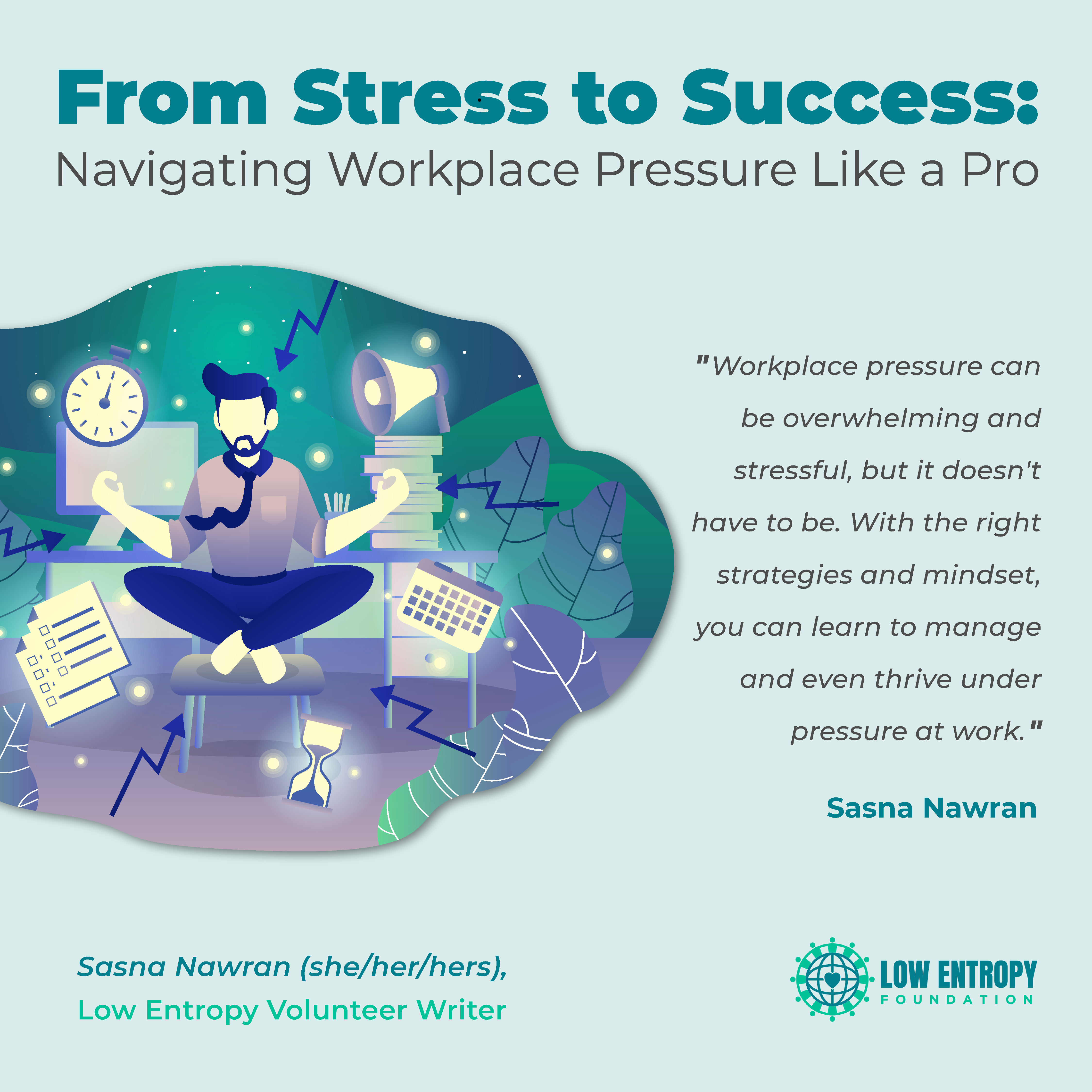From Stress to Success: Navigating Workplace Pressure Like a Pro
August 11, 2023

Sasna Nawran (she/her/hers), Low Entropy Volunteer Writer
Workplace pressure refers to the stress, demands, and expectations that individuals experience in their work environment.
It can arise from various sources, such as heavy workloads, tight deadlines, high-performance expectations, interpersonal conflicts, organizational changes or a lack of resources. Workplace pressure can be both internal (self-imposed) and external (imposed by the organization or colleagues).
In today’s fast-paced and demanding work environments, the ability to navigate workplace pressure with confidence and grace is crucial for personal and professional success.
In this article, we’ll explore the causes of workplace pressure and discuss valuable pstrategies that will help you navigate workplace pressure like a pro.
Causes of Workplace Pressure
- High workloads and tight deadlines
- Unrealistic expectations, either internal or external
- Feeling a lack of control over one’s work
- Difficult relationships or conflicts with colleagues, supervisors or clients
- Organizational changes and restructuring
- Fear of job loss or uncertainty about future employment
- Lack of work-life balance
- The self-imposed pressure to achieve perfection or excessive fear of making mistakes
- An organizational culture that promotes excessive competition, long working hours, or discourages work-life balance
- Insufficient support, inadequate resources or a lack of training and development opportunities
Workplace pressure can be overwhelming and stressful, but it doesn’t have to be. With the right strategies and mindset, you can learn to manage and even thrive under pressure at work.
Below are some tips and strategies for handling workplace pressure.
Recognize and Acknowledge the Pressure
The first step in handling workplace pressure is recognizing its existence and acknowledging its impact on your well-being.
Take the time to identify the specific stressors in your work environment and how they affect you personally. Awareness is key to developing effective strategies for managing pressure.
Prioritize and Plan
When facing multiple tasks and deadlines, it’s important to prioritize effectively.
Start by identifying the most critical and time-sensitive tasks and create a plan of action. Breaking down larger projects into smaller, manageable tasks can help alleviate feelings of overwhelm.
Establishing a clear timeline and setting realistic goals will allow you to focus your energy efficiently.
Practice Effective Time Management
Time management is a fundamental skill when it comes to navigating workplace pressure.
Use tools such as to-do lists, calendars, or project management apps to organize and structure your workday.
Prioritize your tasks based on their importance and deadlines, and allocate dedicated time blocks for focused work. Avoid multitasking, as it can lead to decreased productivity and increased stress levels.
Develop Healthy Coping Mechanisms
Finding healthy ways to cope with workplace pressure is essential for maintaining your well-being.
Identify activities that help you relax and recharge, such as exercise, meditation or hobbies.
Taking regular breaks throughout the day and setting boundaries between work and personal life can also contribute to reducing stress levels.
Cultivate Strong Communication Skills
Effective communication is vital when navigating workplace pressure.
Openly communicate with your colleagues, supervisors or team members about workload, deadlines and challenges.
Express your concerns and seek support or assistance when needed. Clear and open communication can help alleviate pressure and foster a supportive work environment.
Develop Resilience
Building resilience is crucial for handling workplace pressure like a pro.
Recognize that setbacks and challenges are a part of professional life, and view them as opportunities for growth and learning.
Cultivate a positive mindset and focus on solutions rather than dwelling on problems.
Developing resilience will enable you to bounce back quickly and adapt to changing circumstances.
Seek Support and Collaboration
Don’t hesitate to seek support from your peers, mentors and professional networks.
Engage in discussions and share experiences with others who may be facing similar challenges. Collaborating with colleagues can lead to innovative solutions and provide a fresh perspective on managing workplace pressure.
Conclusion
Navigating workplace pressure like a pro requires a combination of self-awareness, effective planning and strong coping skills.
By recognizing and acknowledging the pressure and prioritizing tasks, managing time efficiently, developing healthy coping mechanisms and fostering open communication, you can proactively manage workplace pressure and achieve success while maintaining your well-being.
Remember, everyone goes through workplace pressure at different levels. Therefore it’s not about eliminating the pressure, but learning to navigate it effectively. Embrace the challenge and let it propel you toward personal and professional growth.
—
Leave your thoughts for Sasna in the comments below. You can also follow us on Facebook, Instagram, TikTok, Twitter and YouTube to stay up-to-date with Low Entropy news!
GET INVOLVED
At Low Entropy, we believe changing the world starts with changing ourselves.
Founded in 2015, Low Entropy Facilitates conversations that encourage diversity and promote inclusivity.
We understand that life can be confusing at times. It can seem challenging and sometimes you may feel like no one really “gets you.” We offer an opportunity to connect with others who have the capacity to understand you.









